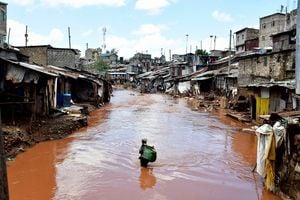What to expect at the sixth UN Environment Assembly

United Nations Environmet Programme(UNEP) Executive Director Inger Anderson(left) talking to Intergovernmental Negotiating Committee (INC-3) Executive Secretary Jyoti Mathur-Filipp after addressing journalists at UNEP headquarters in Nairobi on November 13,2023
What you need to know:
- This meeting will focus on a number of decisions aimed at shedding light on environmental issues and making new commitments.
The sixth session of the United Nations Environment Assembly (UNEA-6) kicks off today. More than 180 country representatives worldwide and thousands of delegates will converge at the United Nations Environment Programme (Unep) headquarters in Nairobi to participate in this grand event.

Executive director of the United Nations Environment Programme Inger Andersen during the interview at United Nations offices in Gigiri, Nairobi on February 22, 2024.
The organisers of UNEA-6 say that this year’s assembly will be the largest ever, with only a handful of countries unable to attend. To get insights into what to expect this year, Hellen Shikanda spoke to Ms Inger Andersen, the executive director of Unep.
What are the top priorities and expectations for UNEA-6?
This meeting will focus on a number of decisions aimed at shedding light on environmental issues and making new commitments. Anyone paying attention to the state of our global environment can see that it is in trouble, especially regarding climate change, biodiversity loss, pollution and waste. UNEA aims to raise the ambition on these three critical issues. The focus will be on addressing issues such as air pollution, hazardous pesticides and their impact on human health, ecosystem restoration and solar radiation modifications.
What is the purpose of meetings like UNEA? Do they achieve actual results?
We cannot expect a meeting to solve a problem overnight, but we know that progress can be made through global cooperation and environmental policies. When we look at successful efforts like the closure of the ozone layer, the phase-out of lead and the end of mercury use, we see that change can occur even if it takes time.
How can UNEA-6 mobilise resources for biodiversity, especially after the passing of the Kunming-Montreal Global Biodiversity Framework?
There is a resolution in the negotiations as we speak that will elevate this work and fast track it. As Unep, we take a leading role in delivering those decisions and supporting member states as they go about it. The text is already out and all we have to do is to ensure that they touch on important elements.
The resolution to end plastic pollution was the biggest outcome of UNEA-5.2. What progress has been made two years later?
We have made significant progress towards our goal, but we haven’t quite reached it yet. While many agreements can take a long time to finalise, we have been ambitious in setting a two-year deadline for this particular one. We have already completed three rounds of negotiations, with the most recent one taking place in Nairobi. The next round will be in Canada, and the final one later this year will be in Korea. The draft text of the treaty has been released and we believe we are making good progress. Our focus is on reducing the use of single-use and short-lived plastics and promoting the circular economy. Additionally, we need to consider the plastic waste that already exists in the environment, such as in oceans and rivers, and how to properly collect and dispose it of. Even after we reduce the use of plastic, this legacy waste will still be present, so it’s important to have a plan for dealing with it.
How can UNEA-6 build upon COP28 language, which talked about transitioning away from fossil fuels for the first time?
Although the language used was not exactly what we had hoped for, it was still a significant achievement and credit must be given to those who made it possible. However, despite this progress, our Nationally Determined Contributions, which are the promises we have already made, will only take us to a temperature increase of 2.7 degrees Celsius. This is not the world we want to live in. While UNEA does not negotiate on this issue, we are committed to prioritising restoration and resilience efforts. Until we take concrete steps to phase down or phase out harmful practices, we must continue to invest in our environmental infrastructure.



